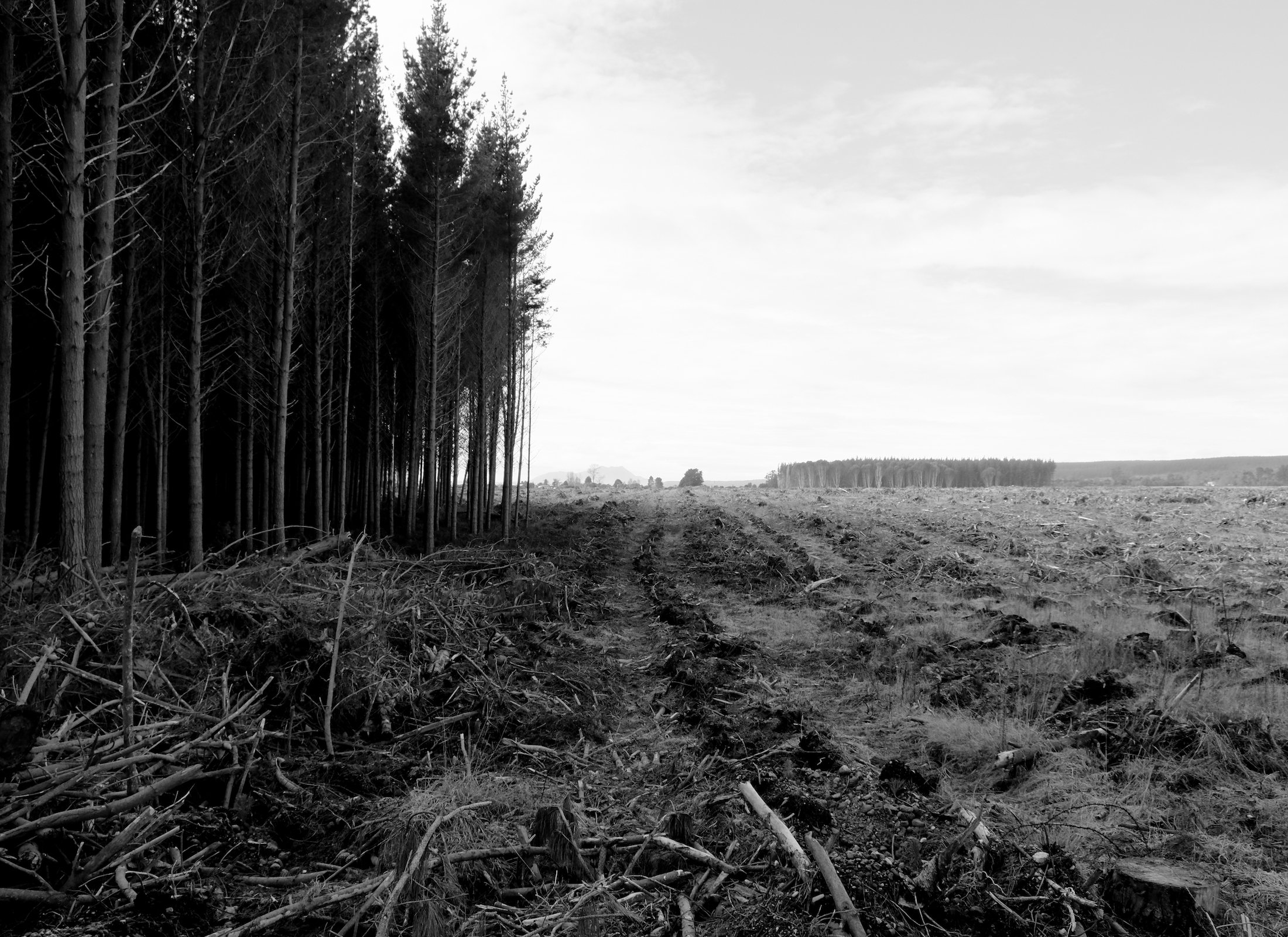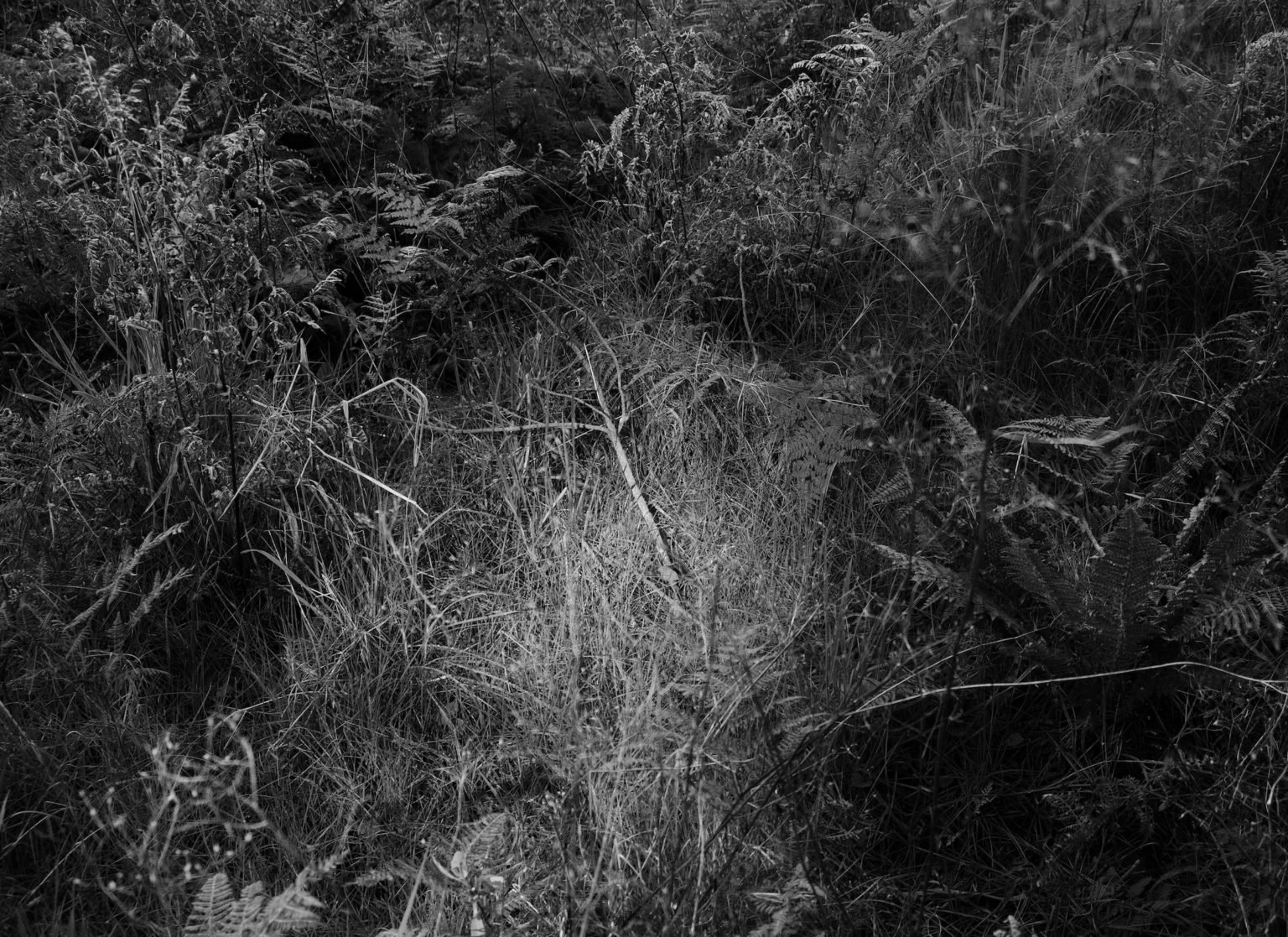Dayle Palfreyman and Isabelle Russell in conversation
RM co-facilitator Nina Dyer speaks to Dayle Palfreyman and Isabelle Russell about their collaborative project Intra-action, a 4-day exhibition on view as part of Aotearoa Art Fair's TENT.
Isabelle Russell, Holding, 2021, pigment print, Ilford smooth cotton rag 310 gsm, 40.5 x 60.2 cm
Nina Dyer: Dayle and Isabelle, this isn’t your first time collaborating on an exhibition project. What first drew you to one another’s practices? Was there a moment where things clicked and you realised you share similar artistic concerns, or did your creative partnership unfold more slowly?
Dayle Palfreyman: I was attracted to the way Isabelle treated space, the presence of the absent body, the duality of organic and inorganic materials, temporality and affect. I realised we shared similar artistic concerns pretty much as soon as I saw her work. It emphasised space and materials in such a way that stretched silent matters to be loud, whether that was literally stretching a several-meters-long bright blue band of fabric in a forest, or emphasising the silence that occupies space. I admired these ambitions and aimed for them in my own work also. We started testing our work in the same space on purpose more often and formed dialogues with each other.
Isabelle Russell: I definitely agree, I really do feel as if we have always shared very parallel visions and intentions when making art. Dayle’s materials are sensitive, tactile and calculated which has always absorbed me. There was a very natural gravitation—we have always been interested in affect, the body and immaterial elements. It didn’t take long before we decided to start installing and curating together as a way to push ourselves and the conversations we were trying to have through our work.
ND: Could you elaborate on that last bit for those who aren’t familiar with your practices? You share an interest in phenomenology, the ways we respond to space and encounter organic forms…
IR: Almost all of the video and installation work I have made in previous years concerned space, staging spatial interventions using textiles and working with non-physical atmospheric qualities. The works we made during our final years of university were primarily concerned with the ways that social, sensory and physical relationships with space are assumed, controlled, and perceived across both private and public spheres.
I think That Which Words Escape, the video we made last year, is a good example of our engagement with some of these ideas—it sought to examine relationships and structures that exist between the body and its surroundings; reimagining the limits or boundaries traditionally drawn between our internal and external worlds.
ND: I remember first encountering your work Dayle in the Fine Arts studios at Massey University, a tree stump sawed in half vertically to reveal a cross-section of the hard and sapwood layers. These were coated in a thick layer of beeswax blended with turmeric and eucalyptus, almost like protective sap to seal off the outer world. The coating was hardened and appeared to be cast, not unlike resin, yet it was in fact subject to the temperature of the room and body heat. This work comes to mind when I read the project description for Intra-action, which cites the entanglement of human and non-human subjects; and when looking at Isabelle’s photograph of a partially-felled forest in this exhibition.
DP: Beeswax is an incredibly autonomous natural material that responds very loudly to its environment. High temperatures allow for the beeswax scent to be released when heat and pressure change its structure. It’s a material that connects with the body through scent and touch, people are immediately absorbed in its presence as it dominates space.
Our interest in the entanglement of human and non-human subjects led us to explore this idea independently with natural materials and environments, often with a camera in hand to capture bodily forms, decay, and texture. I find that the body responds to the tactile language, the structural appearance, embedded in natural materials. There is an emotional response that arises when certain structural forms hold narratives of body and place
We see countless examples of art that replicates this tactile language. It’s a known form of communication—indigenous art has engaged with our innate relationship to natural structures for centuries. I’m interested in what happens when we manipulate these structures in the context of industrial materials and Western ideologies. Given the current industrial and technological urban environments, how do we navigate this manipulation of natural structures? Decolonisation methodologies and the preservation of our natural environment is one place to start.
ND: Isabelle, was there a specific site you sought out for your images, or did you chance upon them with a camera?
IR: This body of work emerged as a result of consecutive weeks spent in a small town between the edge of Lake Taupō and Lake Taupō Forest. Walking along or through the forest on most days lured me into a rabbit hole of research regarding New Zealand forestry practices, land ownership in the area, and the sustainability of such industries. So to answer your question, no, this wasn’t a site I necessarily sought out for the project, but a documentation process. It developed as a way to preserve significant encounters I had with this place, a point where I began to see parts of my research materialise before me. The creation of these works led to a vein of research that has helped me articulate ideas in ways I had been searching for; and has been pivotal for the direction I would like to take my practice in moving forward
ND: These photographs feel quite atemporal with their black and white tones and the subject matter, as though they could have been taken in the 1860s when European settlers deforested native rakau in the Hauraki Plains, mirrored the other day when a kahikatea forest was felled by developers in rural Ardmore, South-East of Tāmaki Makaurau’s CBD.
IR: It’s interesting you mention that; trees really are inadvertent monuments of time in that they silently bear witness to historic events such as colonisation. Seeing native forest being cleared for farming use or housing developments can be a very painful thing to watch—the fragments remaining of kahikatea forests as you mentioned represent such distinctive and valuable stories that need to be preserved. Trees have and will always continue to shape human civilization. Through these photographs I suppose I am trying to invite the viewer to connect with the idea that trees, although non-human, play an indispensable role in our lives.
The series is also concerned with the separateness we impose between ourselves and natural species, committing them to a status of passivity or perceived non-sentience. This treatment is often seen when profit, labor or material demands creep into the equation. The project also aims to navigate some of the implications of commercial forestry in Aotearoa, a heavily westernised industry and an ongoing effect of colonisation. There are evident differences between indiginous and pākehā treatment of this whenua. I think it’s important to acknowledge the dichotomous relationships to land that exists in this country; moving forward we should all consider the ways connection, value and respect can be found beyond tangible or transactional means.
ND: And your installation Dayle, 28 of your baby teeth cast in silver—I love the paradoxical way these feel at once fragile and permanent, by virtue of combining an experience so ephemeral with cast metal. They also have a sort of memento mori feel to them, in that baby teeth remind us of the transience of our earthly existence.
DP: The fragility of baby teeth to me exists when the teeth are removed from the body. The removal of bone from flesh. A part of the body that is relied upon then shed away. The sheer excitement that occurs when you know that new teeth are growing back. Loss is very present here when I think of that phase of childhood from the perspective of the child and the mother definitely. This loss often leads to the preservation of baby curls, first hair cuts, baby teeth, or other extensions of the body such as clothing or shoes.
ND: The choice to cast the baby teeth in silver also brings to mind the way in which incinerated bodies can only be identified by dental records, all other recognisable features having evaporated in the flames—signifying not so much fragility but endurance.
DP:Interesting that you mention forensics. The teeth are the strongest part of the body and unlike bones are non-regenerative. Teeth can withstand high temperatures and are one of the last elements of the body to decompose. There is a fragility that exists in what is lost or could be lost, which is where the value of teeth lies. The choice of silver does reflect the endurance of teeth, however, the history of silver is what interested me the most. When thinking about baby teeth in a biological and psychological context I wanted to enact a similar process with silver. How does this material exist, how has its presence affected, shaped and reflected its environment, and what relationship does it have with other objects.
ND: The premise for TENT is that galleries are tasked with exhibiting anywhere in Aotearoa for four days, so long as the exhibition is presented off-site. What has it been like preparing work for TENT? Has the occasion afforded an opportunity to think about your practice differently, perhaps anticipating a new audience? What has been the most challenging aspect of this project?
IR: Considering the audience and the other 100+ artists involved in this event, we did take a slightly different approach to preparing for the show. We were very set on creating two new bodies of work to share, which of course came with its own set of challenges. TENT has been an opportunity to extend the breadth of our practices while realising our ideas through alternate formats, such as sculptural and photographic methods we weren’t as acquainted with, demanding really tight time management skills for planning and realisation. This has allowed us to engage further with how our individual practices situate against one another, revealing even more of the connective threads that bind our sensibilities and ideas together. The most challenging aspect for me has been bringing my photography into a physical viewing setting, stepping outside of my usual comfort of installation art to engage with more digitally-focused processes; it’s opened my eyes to the intricacies of image making.
DP: TENT has provided the opportunity to think about our work differently. It also reaffirmed feelings towards the direction we both want to take with our practices, regardless of the anticipated audience. Producing new work with unfamiliar mediums in the timeframe allowed for the conceptual element of the work to guide us through the process. As Isabelle has mentioned, this has highlighted and strengthened connections that already existed in the way we both work. The most challenging aspect for me has been producing a new sculptural installation piece straight after closing my previous show. We did have the opportunity to present previous work, but what fun would that have been?
Isabelle Russell, Listening Together, 2021, pigment print, Ilford smooth cotton rag 310 gsm, 40.5 x 60.2 cm
Dayle Palfreyman, Baby Teeth, 2021, silver, 28 teeth at approximately 10 x 0.6 cm
Isabelle Russell, Transmute, 2021, pigment print, Ilford smooth cotton rag 310 gsm, 40.5 x 60.2 cm
Dayle Palfreyman, Baby Teeth, 2021, silver, 28 teeth at approximately 10 x 6 cm
Isabelle Russell, Passenger, 2021, pigment print, Ilford smooth cotton rag 310 gsm, 841 x 594 mm.
Isabelle Russell, Knowingness, 2021, pigment print, Ilford smooth cotton rag 310 gsm, 40.5 x 60.2 cm







